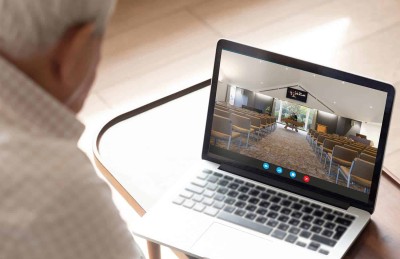Incorporating technology in memorial services
"Will Mum be able to watch the service from her hospital bed?" This question, asked by a grieving son, reminds us why technology has become such a valuable part of modern memorial services. While some might worry that technology could make a funeral feel less personal, I've seen how, when used thoughtfully, it can create more meaningful and inclusive memorial experiences.

One of the most significant changes has been the ability to include loved ones who can't attend in person. Live streaming has become increasingly common, allowing family and friends from around the world to participate in the service. One family told me, "Having Dad's brother in Scotland join us via video made it feel like our family was complete, just as Dad would have wanted."
Creating lasting digital memories
Memorial videos and photo slideshows have become a beautiful way to celebrate a life. These visual tributes can capture moments from different stages of a person's journey, often set to their favourite music. I've seen how these presentations can bring smiles and tears, helping mourners remember the loss and the joy and love shared over a lifetime.
Technology can help create more participatory memorial experiences. Digital guestbooks allow attendees to share memories and messages that families can revisit later. QR codes placed at the service can direct people to online memorial pages where they can contribute their own photos and stories. Zoom, as a two-way platform, provides families and friends separated by distance with the ability to share tributes personally. Some families even create memorial websites that become lasting tributes, growing richer with shared memories.
Practical considerations
If you're planning to incorporate technology into a memorial service, here are some important things to consider:
Always have a backup plan: Technical issues can happen at any time. Have backup devices ready, test everything thoroughly before the service, and consider having a tech-savvy person designated to handle any issues. As one funeral director wisely shared, "Hope for the best but prepare for everything else."
Privacy and permissions: When recording services or sharing photos online, respecting privacy preferences is crucial. Some attendees might not want to be recorded, and some families might want to limit online sharing. Clear communication about how technology will be used helps everyone feel comfortable.
Cultural considerations: Different cultures have varying views about technology in memorial services. Some embrace it fully, while others prefer more traditional approaches. I've noticed that some cultures have specific protocols for photographing or recording certain ceremonial elements. Always check with families about their cultural preferences and traditions.
Music and sound: Digital music platforms have made creating personalised playlists for services easier. However, it is important to ensure you have proper equipment for clear sound quality. Having downloaded versions of songs rather than relying on streaming can prevent technical difficulties.
When it comes to ensuring that any technology used in a memorial service runs smoothly and without issue, consulting a funeral director can be invaluable. They have the experience and expertise to oversee the technical aspects of the service, ensuring everything from equipment setup to troubleshooting is handled seamlessly. This allows families to focus on the emotional and personal aspects of the service, knowing that the technology will work as intended.
A warning about online access
It's important to note that most funeral live streams are provided free of charge by funeral homes as part of their service. Unfortunately, there have been instances of scammers trying to profit from grief by creating fake streaming links and charging people to watch services online. If you receive a request to pay for accessing a funeral live stream, contact the funeral home directly to verify – it's very rarely a legitimate charge.
Reputable funeral homes will provide clear instructions about how to access their live streams, usually through their own website or a trusted streaming platform. These details typically come directly from the funeral home or the immediate family. If you're unsure about any communications you receive regarding online access to a funeral, check with the family or funeral home before clicking links or making payments.
Recording for posterity
Many families now choose to record services for future viewing. This can be particularly meaningful for young children who might want to learn more about their loved one when they're older or for those processing their grief who find comfort in revisiting the service. One mother told me, "My daughter was too young to remember the service, but now she can watch it and see how much her grandmother was loved."
While technology offers many possibilities, it's important to find the right balance for each unique situation. Sometimes, simpler is better. Technology should enhance, not overshadow, the essential human elements of gathering to remember and honour a loved one.
As technology continues to evolve, we're seeing new possibilities emerge. Virtual reality experiences, holographic messages, and interactive memorial spaces are becoming more accessible. While these might not be right for everyone, they offer new ways to preserve and share memories.
The key to successfully incorporating technology in memorial services is ensuring it serves a meaningful purpose. Here are some questions to consider:
- Will this help include people who otherwise couldn't participate?
- Does it add value to the memorial experience?
- Is it in keeping with the wishes and values of the person being remembered?
- Will it provide comfort and support to those grieving?
While screens and devices may seem at odds with the deeply personal nature of a funeral, they can bridge distances, unite communities, and create lasting tributes. One elderly gentleman recently told me, "I couldn't travel to my sister's service, but being able to participate from home made me feel like I was there in the front row." It's moments like these that remind us of technology's true value – not as a replacement for traditional practices, but as a way to enhance the experiences we share.
Sam - representing the Funeral Directors Association of New Zealand (FDANZ).